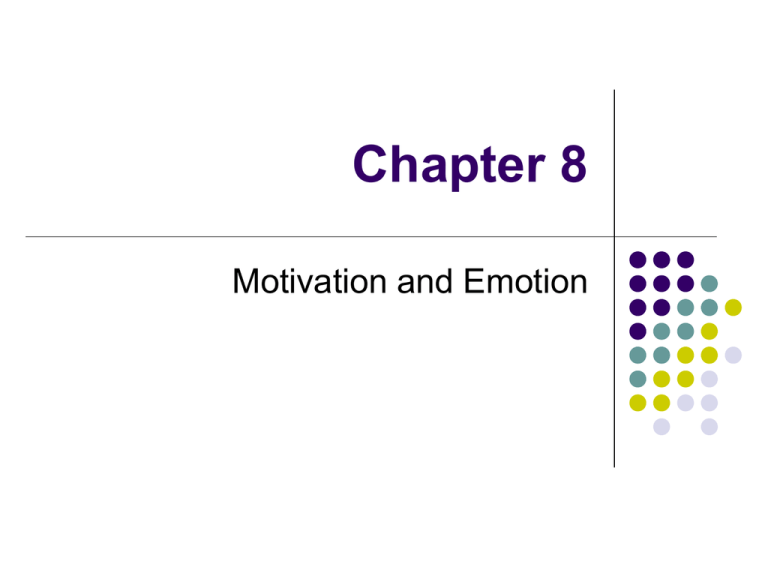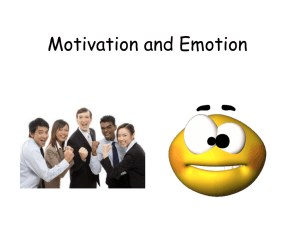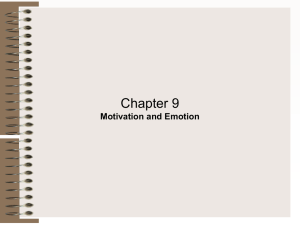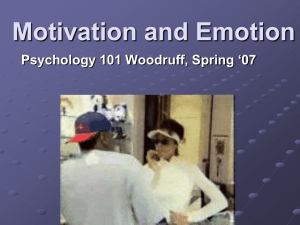
Chapter 8
Motivation and Emotion
Motivation Concepts and Theories
Motivation—factors within and outside
an organism that cause it to behave a
certain way at a certain time
Drive—an internal condition or impulse
that activates behavior to reduce a need
and restore homeostasis
Incentive—external goal that “pulls” or
“pushes” behavior
Theories of Motivation
Instinct—motives are innate
Drive—biological needs as motivation
Incentive—extrinsic things push or pull
behavior
Arousal—people are motivated to maintain
optimum level of arousal
Humanistic—hierarchy of needs
Arousal Theory
Drives as Tissue Needs
Homeostasis—the constancy of internal
conditions that the body must actively maintain
Drives may be due to an upset in homeostasis
inducing behavior to correct the imbalance.
Animals do behave in accordance with their
tissue needs (e.g., increasing or decreasing
caloric intake, drive for salt).
However, homeostasis cannot explain all drives.
Drives as States of the Brain
Cerebral cortex
Hypothalamus
The hub of
many central
drive systems
lies in the
hypothalamus.
Portion of
limbic system
Pituitary
gland
Brainstem
Hunger Drive
Two areas of the
hypothalamus, the
lateral and
ventromedial areas,
play a central role in
the hunger drive
Hypothalamus
Hypothalamus
Hunger Drive
Other stimuli that act on the brain to
increase or decrease hunger include:
satiety signals from the stomach (CCK)
signals indicating the amount of food
molecules in the blood (insulin)
leptin, a hormone indicating the amount
of fat in the body
internals vs. externals
Research on Weight
Regulation and Dieting
No consistent personality trait differences
found between obese and non-obese people
(e.g., willpower, anxiety)
Dieters and obese are more likely to eat in
response to stress than non-dieters.
Family environment of little importance in
determining body weight; genetics plays a
large role
Number of fat-storage cells is a major
determinant of body weight.
Research on Weight
Regulation and Dieting
Fat cells are determined by genetics and food
intake
They increase with weight gain, but merely shrink
with weight loss; may stimulate hunger
Weight loss causes a decline in basal metabolism
Fat cells
Normal
diet
High-fat
diet
Return to
normal diet
Ob/Ob Mice lack the ability to produce leptin and
therefore the mice think body fat stores are comletely
depleted and continue to eat.
Effects of Culture and
Habits on Body Weight
Baseline body weight—cluster of genetic
and environmental factors that cause a
person’s weight to settle within a
given range
Weight can be affected by factors like
diet, exercise, and daily habits (e.g.,
stairs instead of elevator)
Basal Metabolic Rate
The rate at which the body uses energy
for vital functions while at rest
Factors that influence BMR
Age
Sex
Size
Genetics
Food intake
Excess Weight and Obesity
Obesity—condition characterized by
excessive body fat and a BMI equal to or
greater than 30.0
Overweight—condition characterized by
BMI between 25.0 and 29.9
Factors Contributing to Being Overweight
Highly palatable food—we eat because it tastes
so good
SuperSize It—food portions are larger than
necessary or health
Cafeteria Diet Effect—more food and more
variety leads us to eat more
Snacking—does not cause us to eat less at
dinner
BMR—changes through the lifespan
Sedentary lifestyles
Factors in Obesity
Genetic susceptibility—some people are
more likely to be predisposed to obesity
Leptin resistance—condition where higherthan-normal levels of leptin do not produce
desired physiological response
Weight cycling—repeated dieting, weight
loss, and weight gain tends to result in
higher weight and reduced BMR
Eating Disorders
Anorexia nervosa—characterized by
excessive weight loss, irrational fear of
gaining weight, and distorted body image
Bulimia nervosa—characterized by binges
of extreme overeating followed by selfinduced purging such as vomiting,
laxatives
Binge-eating—disorder characterized by
recurring episodes of binge eating without
purging
Human Sexual Response
Stage 1: Excitement—beginning of sexual
arousal
Stage 2: Plateau—increased physical arousal
Stage 3: Orgasm—male ejaculates, female
vaginal contractions
Stage 4: Resolution—arousal subsides
What Motivates Sexual
Behavior
Necessary for the survival of the species
but not of the individual
Lower animals motivated by hormonal
changes in the female
Higher species less influenced by
hormones and more by learning and
environmental influences
Sexual Orientation
Sexual orientation—direction of a person's
emotional and erotic attractions
Heterosexual—sexual attraction for the opposite
sex
Homosexual—sexual attraction for the same sex
Gay—typically used to describe male
homosexuals
Lesbian—typically used to describe female
homosexuals
Bisexual—sexual attraction for both sexes
Determination of Sexual
Orientation
Genetics—role suggested by twin and
family studies
Brain structure—differences found in
hypothalamus of homosexual and
heterosexual men
Complex issue with no clear answers
Some General Findings
Sexual orientation is an early-emerging, ingrained
aspect of the self that probably does not change.
No consistent relationship between orientation and
childhood experiences (e.g., parenting, abuse,
sexual experience)
Controversial findings suggest a possible
relationship among prenatal stress, androgens, and
the development of brain systems that play a role in
sexual attraction.
Sexual Attitudes and Behaviors
Reported differences between males and
females in these areas have become less
pronounced since the 1960s.
Recent meta-analyses indicate that men
tend to have more sexual partners,
experience first intercourse at an earlier
age, and masturbate more frequently than
women.
Sexuality in Adulthood
Majority of adults (80%) report having none or one
sexual partner in the past year (marriage factor).
Majority of men ages 18-59 have sex about seven
times per month.
Majority of women ages 18-59 have sex about six
times per month.
Vaginal intercourse is nearly universal as the most
widely practiced sexual activity among heterosexual
couples.
50 percent of older Americans reported sexual activity
at least once per month.
Sexual Disorders and Problems
Sexual dysfunction—consistent disturbance in
sexual desire, arousal, or orgasm that causes
psychological distress and interpersonal
difficulties
41% of women and 31% of men report sexual
problems
Low desire and arousal problems common
among women
Premature ejaculation and erectile problems
common among men
Gender Identity Disorder
Persistent discomfort about one’s physical
gender along with the desire to be a
member of the opposite sex
Previously termed “transsexualism”
May undergo hormone treatment or sexreassignment surgery
Sexually Transmitted Diseases
(STD)
STD—any of several infectious diseases
transmitted through sexual intercourse or other
sexual contact
Of the 12 million cases of STDs diagnosed
annually in the US, about 8 million are among
people under 25 years of age
Many STDs have mild or no symptoms, yet left
untreated can cause serious health problems
AIDS Epidemic
Acquired immune deficiency syndrome—caused by
exchange of bodily fluids (blood, blood products,
semen) containing the human immunodeficiency virus
(HIV), which attacks and weakens the immune system
HIV can stay in the body for many years without
apparent symptoms
As the HIV attacks the immune system, the person
becomes very susceptible to other opportunistic
diseases (pneumonia, cancers)
Highest risk groups are gay men, IV drug users
sharing needles, and people with multiple sex partners
Prevention and Treatment
There is currently no cure for AIDS, but it can be
treated with complex “drug cocktails,” which
improve quality and duration of life but have
many side effects and are extremely expensive.
Prevention is possible using condoms, not
engaging in other high risk behaviors such as
sharing needles, and improved blood screening
and infection control in health care settings.
Humanistic Theories
Abraham Maslow suggested that motives
are divided into several levels from basic
survival needs to psychological and selffulfillment needs.
Self-Determination Theory
Optimal human functioning can occur only
if the psychological needs of autonomy,
competence, and relatedness are met.
Proposed by E. L. Deci and R. M. Ryan
Self-Determination Theory
Autonomy—need to determine, control,
and organize one’s own behavior and
goals
Competence—need to effectively learn
and master challenging tasks
Relatedness—need to feel attached to
others
Arousal Theory
People are motivated to maintain an
optimum level of arousal—neither too
high nor too low
Curiosity motive—helps us understand
our environment
Sensation Seeking
A person high in sensation seeking
tends to look for exciting (and
sometimes risky) activities.
Competence and Achievement
Competence motivation—behavior aimed
at demonstrating competence and exerting
control in a situation
Achievement motivation—behavior aimed
at excelling, succeeding, or outperforming
others at some activity
Concept of Emotion
A class of subjective feelings elicited by
stimuli that have high significance to an
individual
stimuli that produce high arousal generally
produce strong feelings
are rapid and automatic
emerged through natural selection to benefit
survival and reproduction
Basic Emotions
Fear, surprise, anger, disgust, happiness,
sadness
Basic emotions are innate and “hardwired”
Complex emotions are a blend of many
aspects of emotions
Classified along two dimensions
Pleasant or unpleasant
Level of activation or arousal associated with
the emotion
Physical Arousal and Emotions
Sympathetic nervous system is aroused
with emotions (fight-or-flight response)
Different emotions stimulate different
responses
Fear—decrease in skin temperature (cold-feet)
Anger—increase in skin temperature (hot
under the collar)
Fear
Brain and Emotions
Amygdala
evaluate the significance of stimuli and generate
emotional responses
generate hormonal secretions and autonomic
reactions that accompany strong emotions
damage causes “psychic blindness” and the
inability to recognize fear in facial expressions
and voice
Emotion and Facial
Expressions
Each basic emotion is associated with
a unique facial expression.
Facial expressions are innate and “hardwired”.
Innate facial expressions the same across
many cultures.
Display rules—social and cultural rules
that regulate emotional expression,
especially facial expressions.
Theories of Emotion
Common-Sense Theory
Stimulus
Perception
Emotion
(Tiger)
(Interpretation
of stimulus—
danger)
(Fear)
Bodily
arousal
(Pounding
heart)
Common sense might suggest that the
perception of a stimulus elicits emotion
which then causes bodily arousal
James-Lange Theory
Two-Factor Theory
Cognitive-Mediational Theory
Emotions result from the cognitive
appraisal of a situation’s effect on personal
well-being.
Similar to two-factor, but cognitive
mediational theory’s emphasis is on the
cognitive appraisal as the essential trigger
for the emotional response









